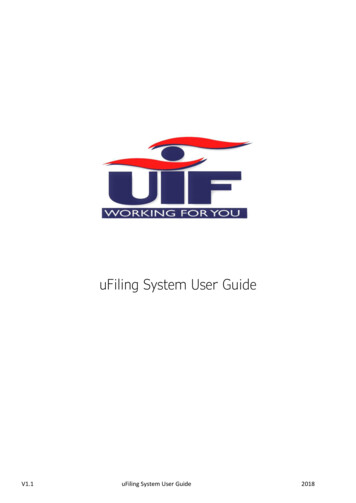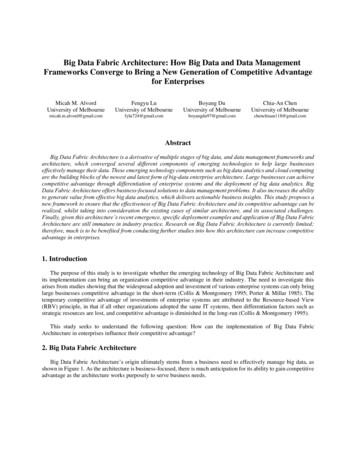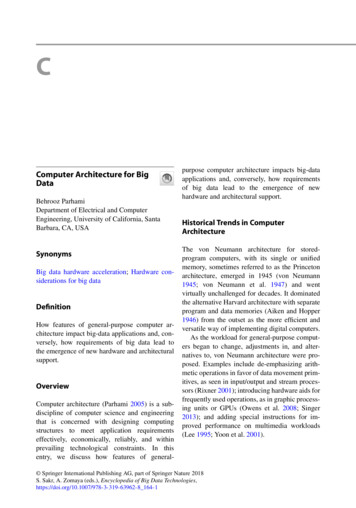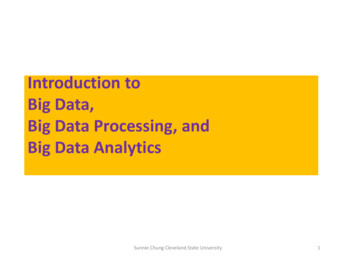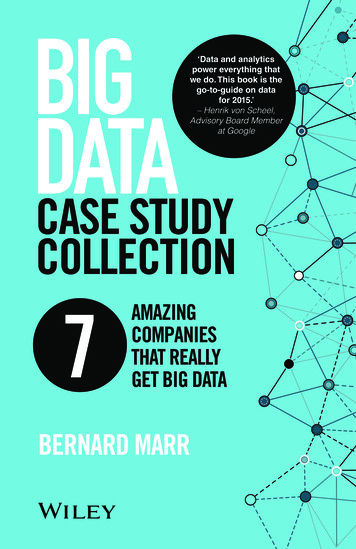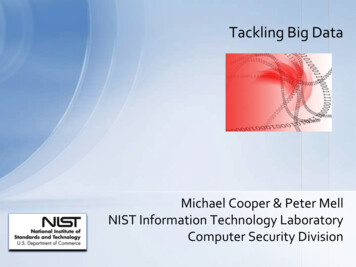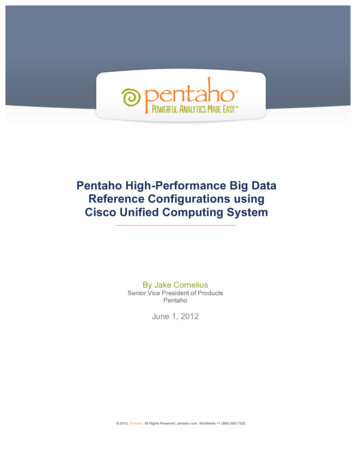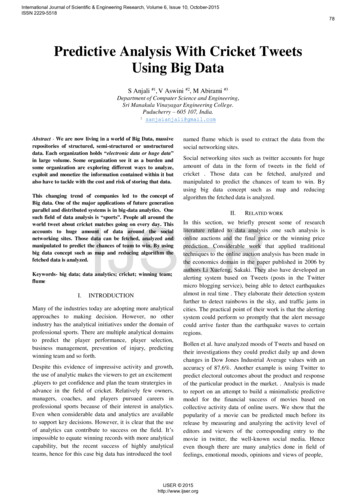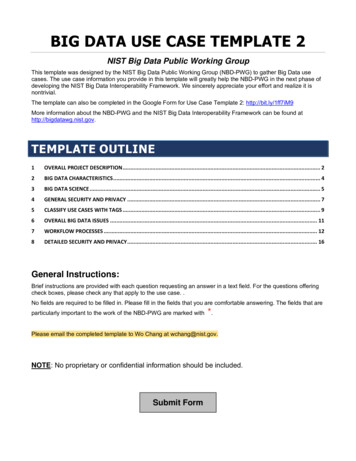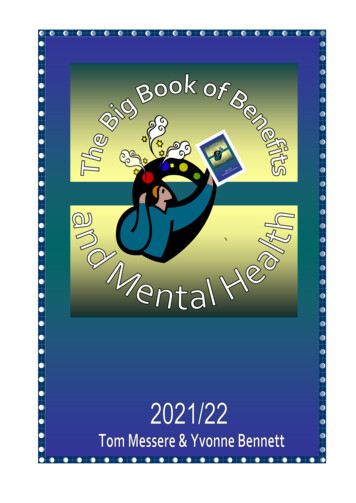
Transcription
Big Book of Benefits and Mental Health 2021/21www.bigbookofbenefits.com
“An essential piece of kit ”Community Care MagazineNow in its 19th edition, this Big Book offers 500 pages of user-friendlypractical information, tips, tools, tactics, health assessment forms (pageby page guidance and tips), effective support letters, caselaw andexample appeal submissionsAn essential resource to help make your own claims or support those forothers, especially if living with mental health issuesBut many others find the Book invaluable for all sorts of generalinformation and making sense of an increasingly confusing, changingand sometimes chaotic benefits. More specific content around mentalhealth can also spark ideas in other hard to express health issues too.Written by: Tom Messere - welfare rights adviser for way too long, freelancebenefits trainer and former partner in crime of founding author Judy Stenger (whosewarmth, wit and wisdom still pervades the pages). And Yvonne Bennett, welfarerights adviser of many years, supporting front line workers and winning appeals.NEW / UPDATED FOR 2021/22:Benefit changes: revised and updated overview and charts covering recent pandemic and other changes and a newchapter on the HMRC Emergency Coronavirus Support Schemes.Personal Independence Payment: the latest on anti-mental health discrimination, change in assessments processes,case law, and a new approach starting in Scotland later in 2021 And all that practical help with PIP2 formsSickness benefits: Making sense of the sickness benefits scene: what is going and what stays changing mix of sickness;issues when swapping from income-related ESA to UC, how the ESA/UC Work Capability Assessment works with page bypage guidance through an example form, how to effectively support and challenge claims and ESA changes in doing that.Universal Credit: now split into two. Part 1: a practical guide to how UC works, moving over to it, claiming, the UCsums , practical tips and pitfalls to avoid in surviving UC . Part 2: separates out more complex and problem areas into theirown chapter alongside reports and calls for change. and calls for change.See our contents pages for further info and all the other fully updated chapters contained withinFEEDBACK FROM PREVIOUS EDITIONS:“An essential piece of kit for all community mental health teams,“There really is everything you need here As a tactical handbook thatis not frightened to give its opinion on the current direction of socialsecurity it is unrivalled”Advisor magazinecommunity psychiatric nurses, approved social workers and voluntarygroups as well as general benefit advisers. If you have a mental healthproblem and are trying to cope with the benefit system or if you’re aprofessional wanting to give good solid advice there’s no better guidethat you can buy.”Community Care magazine“Absolutely superb - extremely impressive”Director - Local Mind Association“These books have been a goldmine for my Community Support Teamand Housing Support Staff”team leader“Your book has brought positive results to so many of my clients and isa joy to work from. Its humour, readability and understandability makesit the best of ways of finding information and gives hope to people wading through the treacle of the Benefit system.” support worker“I have been a benefits adviser for 15 years & bought this book withsome doubt, concerned that I might be paying for 'rehashedinformation'. I just wanted to say how delighted I am, I never thought Iwould take a benefits book to bed but I could not put it down. Youexplained dry legislation and complex rules in a personal and engagingmanner, with even a few laugh out loud moments! Explanations areclear and lucid, examples appropriate & diagrams summarise issues inan approachable and accessible way ”benefits adviser“The book puts into words my own experiences, feelings andthoughts.”service user“Has been massively important for service users”support worker“This substantial but tremendously accessible handbook could well beone of the most useful guides around .”Health and Care.com“I have recently acquired the book which is actually an amazingdocument. I cannot praise it enough service user & advocate“The PIP form took half the time and was more detailed than it wouldhave been”social worker“Judy’s work made more of an impact on the quality of life of ourservice users than any pills, potions, therapy or support we were able tooffer”mental health team leader“Made me re-assess how I approached the form - I was awarded ahigher rate of PIP ”service user“The forms practically write themselves” housing support worker 28.00Free updates to April 2022 and other info at: www.bigbookofbenefits.comAvailable from: CPAG and all good bookshopsand now alternatively available as an e-publicationBig Book of Benefits and Mental Health 2021/22www.bigbookofbenefits.com Tom Messere & Yvonne Bennett 2021 Published by Big Book of Benefits: www.bigbookofbenefits.com Facebook: Big Book of Benefits
Welcome to this nineteenth edition of The Changes to benefits and this editionBig Book of Benefits and Mental Health. If These include:you are new to the Big Book, we hope you will putting on weight and full updating / revising inlike its friendly, practical, “tell it how it is”every chapter, with the latest rates, implementationapproach.plans and changes and Covid impacts.While this book has a mental health focus in tips andexamples, readers also tell us that its practical toolkitapproach also helps with claims across other health anddisability issues too. And means tested benefits andUniversal Credit apply to all, as we each struggle to benames, not just numbers, in the benefit sums :-)Changes here at Big Books welfare reform overview and tables updated, withcovid related and other recent changes highlighted. the sickness route to benefits - updates on how thenew mix of sickness benefits fit together and keydifferences in how the same assessment operates inESA and UC. What’s the latest on switching, protectingany SDP and news on ESA pending appeal? Universal Credit - DWP liked to say UC is “sosimple", but we have had to split it into two chapters: Part 1: a practical toolkit to get through UC; and Part 2: a look at more complex and problem areas.UC, as an IT project, did really well to take on 2.5million new claims in Spring 2020. But as a benefit, itFor me, a choice had to be made between going full timecan still struggle to meet legal obligations on disability,as an adviser and putting Big Books to one side :-( ormental health and doing sums rationally.focusing on Big Books full time. A busy start to get things Paying for Housing and Benefits and Work updatedgoing, so apologies for running late in getting to you.for HB and UC changes and the latest on bedroom tax.We again welcome Yvonne Bennett as co-author, with PIP now covers ADP to come - we catch up withher immense experience of work with clients with mentaltwists in unlawful disability discrimination, small hopeshealth issues, her geek fascinations and appeals success :-).of DWP improvements and larger ones in Scotland.The book has put on lockdown weight, because of soAt the DWP it’s a slow time of return to “business asmany changes related to coronavirus, both in:usual”, with emergency benefits , uplifts and processes dueto fade by September. But can they learn from changes entirely new Coronavirus benefits from HMRCforced and spotlights shone during the pandemic? big changes to the way the usual benefits operate asAs for everyone, these pandemic times have been ones ofbig changes and challenge. At one point, it seemed as if wewere going to only be able to come out as a virtualpublication, but we are delighted to be here in print, aswell as taking our first hesitant virtual steps too.face to face interactions become very difficult.Real failings have been revealed in the system’s fitness forThese have piled on the pages to a longer running “tale of purpose in this public health emergency. Can it wean itselftwo systems”, as benefits slowly switch over from the old off failed sanctions and snapshot health assessments? Orchange anti-social behaviour against children and people(like DLA and “legacy benefits” ) that many still claim, tothe not quite so new (like PIP and UC) where people now with health issues? Can it forego habits of harming lifestart new claims. So we cover both old and new and the chances and independence ? Can “dignity fairness andrespect” go UK-wide as part of “building back better”?worries around switch overs from one to t’other.Our bindings also burst with happier changes, as we startour coverage of Scottish disability benefits, appearing laterthis year. Switching will be automatic - no re-assessmentsinvolved - but the plans prioritise treating new claimantswith “dignity, fairness and respect”. Not just relevant toScotland, as others may rightly ask “Why not here?”A companion Big Book coming soonPension age” benefits are becoming increasingly separate. Weaim to make good on past promise for a companion Big Bookof Benefits, Money and Older People to: bring back updatedcoverage of AA and DLA, cover State Retirement Pensionchanges, pension choices, wider issues for Pension Credit andother money matters in older age and changing social care.For now, our previous full coverage of AA and DLA is availableas a free download at www.bigbookofbenefits.comGood luckAs Jude wrote: “Certainly for those reliant on benefits paid ongrounds of ill health or disability, anxiety is rapidly becoming away of life rather than a diagnosis.”But we hope we can join you to in shedding a little light inthe darkness. Despite the cuts, financial and emotional,vast sums go unclaimed and incomes can be protected.We hope this Book - and linked training - offers ideas,hope, practical tools and confidence to help make thatdifference between “living and merely existing”.Thank you to all our readers for their work and creativeideas in struggling on through barriers to make claims gobetter for yourself or for others you support.Tom Messere - May 2021Available from: CPAG and all good bookshops Published by: Big Book of Benefitswebsite: www.bigbookofbenefits.comBig Book of Benefits and Mental HealthOur2021/21www.bigbookofbenefits.com Tom Messere & Yvonne Bennett 2021 ISBN: 978-0-9954595-4-0Facebook: Big Book of Benefits
ContentsOverviews and contextsIntroductions1Introduction; Contents; How to use this bookBarriers to BenefitsBenefit complications; Mental health considerations; Discrimination; Anti-claimant rhetoricSteps to Maximum Entitlement - what you can claimThree steps to benefits maximization; Benefits, in brief ; The three steps in practiceBenefit changes an overviewRecent & Covid changes; Austerity cuts and “welfare reform, devolved differences ChangesCharts51329Routes to benefits and Step 1 benefitsTwo key “routes to benefit” for those with mental health issues: “sickness” and “carers” . A look at what’s involved in claimingwhen unwell or as a carer what ever the benefit; this is where we cover these important Step 1 benefits but also how they fitin with Step 2.Sickness Route to Benefits Making sense of changing sickness benefits; Off from work and Statutory Sick Pay; Claims andassessments for Employment and Support Allowance and Universal Credit (sickness); Newmigrations from Income-related ESA to UC; The common Work Capability Assessment (for ESAand UC) - points and prizes; Filling in ESA50 & UC50 forms; Preparing for a “medical”; Writingeffective supporting letters; Challenging WCA decisions; caselaw & appeal submissionsBenefits for CarersCarers Allowance, Who count’s as a carer; Carers Credit, Carers Premiums /addition / elementand limited protection for carers; Welfare reform and carers55127Step 2: Means tested benefitsThe changing face of means tested top ups and safety net benefits - to cover basic living costs and pay the rent and for helpwith one off costs . Some are going to make way for “simple” UC (that needs two chapters )Introducing all means tested benefits and Pension Credit in particularIntroducing all the means tested benefits, common principles; Which are staying and which aregoing; Who claims which one? ; A detailed look at Pension Credit.135Legacy means tested benefitsIncome Support, Income-related ESA, Income based JSA and ; How to do the sums and checkthe amounts, worked examples; Deductions and gapsLegacy tax credits: Child Tax Credit and Working Tax CreditWho can claim?; How much? - elements of maximum tax credit, income, annual reviews andcalculations; Overpayments; Welfare reforms cuts and changes; Passported benefitsThe HMRC emergency Coronavirus schemesThe Coronavirus Job Retention Scheme - current and earlier versions, the abandoned JobSupport Scheme-that may be back after September?; the Self Employment Income SupportScheme; How these affect other benefitsUC Part 1: A practical guide to the workings of Universal Credit.What is UC and why?; Key features and aims; When is UC?; Switching to UC and health issues;Claims and monthly assessments - the five week wait; UC sums - maximum UC v income; UCissues for sickness; Surviving a UC claim; Concerns about the UC schemeBig Book of Benefits and Mental Health 2021/22www.bigbookofbenefits.com167185
UC Part 2: Extra complications and problem areasMigration in more detail: when? How? Protection? The end of the SDP Gateway; Onlineclaiming made hard - Set up to Fail; Admin and decisions issues - The computer says No;Elemental issues - when bits drop off; Disability gaps and other health issues; Pensioner gaps;Reports on UC.Paying for Housing Costs – help with rent, mortgage and council taxHousing Benefit - who can claim, rent restrictions, the Local Housing Allowance andthe bedroom tax); Help with mortgage interest; Differences with Universal Credithousing costs element; Council Tax SupportThe changing Social FundWhat stays, what goes and what’s moved? English local welfare schemes; the ScottishWelfare Fund; the Discretionary Assistance Fund Wales; NI Discretionary Support251273Step 3: Extra non-means tested benefitsHere we focus on the important “disability” benefits, that can make the difference between “living and merelyexisting” as they are paid on top of anything else and can trigger extra help elsewhereIntroduction and a little bit of AA and DLAIntroduction to the disability benefits - Attendance Allowance, Disability Living Allowance andPersonal Independence Payment; Summary of AA and DLA criteria and key differences withPIP; Other Big Book resources to help with AA and DLA formsPersonal Independence Payment (PIP) & Adult Disability Payment (ADP)What is PIP? Why and When? ; PIP claims and assessments: the story so far and top tips;What will be different under ADP in Scotland?; The switch to PIP and PIP renewals; Page bypages tips and examples to fill in PIP 2 forms; Tackling mobility mental health discrimination;Supporting letters for PIP claims; Challenging PIP decisions - PIP Case law, example PIP appealsubmission; PIP differences in N. Ireland and ScotlandMental Health diagnoses and disability benefits281293375A brief guide to common mental health diagnoses and issues for DLA and PIP; Case study: bi-polar disorder, DLA and PIPOther Benefit IssuesWork conditionality and moving into work:Sickness and work conditionality: ESA and UC work related activity; UC conditionality whileyou wait for an assessment; the Health & Work Programme; Safeguarding and challengingsanctions; Surviving as a jobseeker; In Work options: under and over 16 hours; UC WorkRequirements and SanctionsBenefits and Hospital387415What happens to your benefits if you are admittedHow to challenging benefit decisions VonThe importance of not taking “No” for an answer; What are revisions, supersessions andappeals? ; Mandatory Reconsiderations and independent appeals; issues for ESA / UC (forsickness) and PIP; Appeals - the papers, evidence and hearings. See also under each benefitTraining courses & FeedbackYou’ve read the book, now see it live! An updated wide range of training courses linked to theBig Book from beginners to experts. If it’s not on the list, do contact us for something to suit.And let us know what you think of the Book and how we could make it better :-)Benefit Rates Chart 2021 / 2022421430433NB: each chapter has its own detailed ContentsBig Book of Benefits and Mental Health 2021/23www.bigbookofbenefits.com
Access to Benefits and Mental Health IssuesWhen accessing benefits, any or all of the following can be involved: spending ages on ‘hold’having to select from the options withoutknowing what your options aretrying to explain complex, very personalthings - on the phone or in an open-planofficegetting to the Jobcentre or medicalexamining centre by public transporthaving to wait dealing with busy staff who can sometimesseem unsympatheticbeing asked to complete long and complexclaim formsbeing asked to claim on-linekeeping appointmentsbeing asked to submit to medicalexaminationsgetting official letters using language youdon’t understandWhen you live with mental health problems, the following can cause problems: anxiety using the phonefear that your phone calls are somehowbeing ‘monitored’fear of opening your postpanic attacks when outside or dealing withunfamiliar/ crowded settingsa terror of being enclosed on public transportand/ or in waiting rooms/ interview roomsdifficulty remembering things you’re tolda ‘fight or flight response’ when stressed thatresults in angerdifficulties accepting your own problemsdifficulties communicating your problems fear of communicating the extent of yourproblems because of previous compulsoryadmissions/ child protection issuesprevious bad experiences of doctorsproblems with concentration due to sideeffects of medication, anxiety or because ofhearing voicesfeelings that people are against you or wantto harm youfeeling that you are being watched orfollowedfear of ‘officialdom’Financial insecurity and ever changing circumstances are, then, direct consequences of living with mentalhealth difficulties and the resulting anxiety can often, in turn, exacerbate mental health problems. By informingpeople of their rights to Social Security benefits and working with them to communicate their needs,independent advisors can help overcome barriers to benefit.Many of the same difficulties can make it difficult to access advice agencies. There may be ideas in which advice services could rethink and adapt services. For example: provide services at places already familiar to people - drop in centres, day hospital facilities, psychiatric clinics, day caregroups, through home visits etc. actively encourage people to bring company if they feel this will help them offer to accompany people to interviews/medicals /tribunals. work in as informal a way as possible/ try tobe jargon free! aim to involve people in their claims processas far as is possible use non-brown envelopesBig Book of Benefits and Mental Health 2021/2 7hand write non-standard lettersoffer appointments so that people know theywill not have to sit for any length of time ina crowded waiting areaoffer open ended appointments so that eachperson will have the time they need tocommunicate their difficultiesoffer breaks for coffee/ cigarettes - oranything that will make the process morerelaxed and less threateningwww.bigbookofbenefits.com
‘EXTRA’ NON - MEANSTESTED BENEFITSMEANS TESTEDBENEFITSEARNINGS REPLACEMENTBENEFITSAFrom Step 2 If pension age: Pension Credit If working age: either Universal Credit (UC); or“legacy benefits”: Income-related ESA, Incomebased JSA, Income Support, Housing Benefit,Child Tax Credit and Working Tax Credit Council Tax SupportSocial Fund help and its replacementsBut by breaking the benefits system down into ‘steps’ and then working our way from step one through toFrom Step 3:three, (and sometimes back to two - and one - but Personal Independence Paymentmore of that later!) it is possible to feel sure thatThe temporary Covid 19 schemes can be used in somewe’ve considered all the options. And what’s more,we don’t have to sing tunes from the ‘Sound of Music’ sickness situations too: the Job Retention Scheme iffurloughed or Self-Employment Income Supportwhilst doing it.lthough we all probably know about somebenefits, feeling confident that we’ve applied forall the benefits we’re entitled to when the systemis such a maze, is a very different matter. What’smore, the DWP doesn’t have a duty to help us identifybenefits we may be missing out on, so accessing fullbenefit entitlement often depends on knowing theright questions to ask.What follows is an explanation of these three steps ingreater detail, each step being followed by a briefdescription of the benefits on that step. There are alsosome example situations of how the steps stackThe switch to Universal CreditUC is not taking over the benefits world, but it ishaving a big impact at Step 2, as it takes over from theprevious six “legacy benefits” by September 2026.This adds extra issues of which system and how toBenefits most likely when unwellswitch. But UC’s aim - once done - is to make thingsMany of the benefits most likely to be of relevance to simpler: e.g. no working out which legacy benefitspeople facing mental health problems are also covered applies nor switching between them if things change.in far greater detail later on in this book.Sadly, though, it’s been a missed opportunity to leaveThese include:some complications behind, while UC has added afew of its own. Cuts have added complexity andFrom Step 1:confusion not planned in the original UC design. And Contributory Employment and Supportthe promised Universal Support to help those whoAllowance (C-ESA)may struggle with UC, has been rather forgotten, to Carer’s Allowance (CA)the dismay of UC’s founding father :-(Big Book of Benefits and Mental Health 2021/217www.bigbookofbenefits.com
Changes related to coronavirusNote: changes evolved over these months so dates of introduction of measures are less relevant as measures have beencontinuously amended and a planned “return to normal” procedures rather pre-announced. The aim is broadly a phased return tonormal from July 2020, but emergency measures may return in response to second waves of both huge numbers needing to claimUC or of coronavirus infections.ChangeNotes & CommentSupport during self-isolation shielding This was to make it financially possible to follow self-isolation guidelines.Statutory Sick Pay (SSP) from day1 instead of day But a convoluted and still very basic income, with many low paid workers4. HMRC covers for 2 weeks for small employers. unable to afford to drop down to SSP levels e.g. a major issue in the failureto protect care home residents.Contributory ESA - paid from day 1 rather thanOther countries could rely on sickness benefits of c 200 a week with topday 8 but not increased to match SSP . This isups to incentivise and support compliance.done via UC or WTC and linked HBA belated 500 allowance for self isolation has failed in England , butUC standard allowances increased - extended todone better with top ups in the other nations - less restrictions/more30th September 2021 to match SSP ratesfunding. A big impact on people’s ability to self isolate.Underfunded 500 in England , with betterIncreases to UC to match SSP while welcome, tended to help younger andprovision in the devolved nationsunemployed claimants and leave out older and the unwell and disabledwho are mainly on legacy benefitsNo GPs sick note but an NHS online noteaccepted. Back to sick notes on all claims from July Longer term absences - e.g. when shielding - have mainly been dealt withby furloughing rather than SSPMeasures extended to those “shielding” for longerperiods when following NHS advice, but not ifquarantining on return from abroad.SummaryEntirelytablesof thecutsandnew “emergencytax credit”schemesfrom HMRC aimed to putthe economy on hold rather than let mass unemployment rip. InJob Retention Schemes - for employeeschangeslockdowns.arrangedby startedtypesof led to big wave of UCGetting scheme- esp. SEISS. Some 2 million freelancers etc. fell between the schemes. InitiallySelf Employment Income Supportbenefitsclaimstacklethe offsformsforyou3 monthsbut extensions/rollthereafter. Due to finish on 30thNew Covid schemes September 2021. See tax credits chapter for history and current criteria.Changes to UCChanges in processes: to deal with 2.6 million newclaimants peaking at 640,000 in one week in latemarch (compared to normal 55,000pw) “Don’t call us, we’ll call you” no longer need to setup post claim interview. Local JC offices closed Extension of existing Verify.gov online verificationbut can also use a Government ID. Not operationally possible to not reclaim AdvancePayments - as in other DWP recoveries- see below Changes in work conditionality, health assessmentsand housing element - see below “Minimum Income Floors” for the self employed,waived for those affected by impacts Managed migration pilots stopped and start up ofmain managed migration uncertain.NB: Since January 2021 a new phased back to normalsee below. Double check on info at end of claim, andlocally for your area / in your case.(NB: table continues on next page)Big Book of Benefits and Mental Health 2021/2The usual processes of UC could not cope both with sheer numbers andwith need to rethink face to face interactions. See details on next page /side of this table re work condionality and health assessments .DWP staff transferred from other benefits to support UC, as the priority ,but did affect capacity and contact with other benefits. DWP succeeded inpaying out UC without big delays, which was no mean feat.Many self employed found themselves claiming UC and—whether paid ornot - losing access to previous legacy benefits by doing so. Hopes of goingback to legacy benefits were dashedThe hold on managed migration pilots has also delayed the nationalrollout . New dates for restarts awaited. The Office for BudgetResponsibility were already allowing for September 2026 for completion,rather DWP estimate of 2024. Both dates are likely to slip. Each year ofdelay saves 700 million in unpaid transitional element.DWP anticipate a surge in applications when furlough/SEISS schemes doend - now in September 2021. But have experienced smaller surges inuncertainty ahead of each further extension being announced.An announcement of almost overnight back to normal from the 6th July2020 turned into a slower “phased re-introduction”. But then tightenedagain as second wave hit. January 2021 saw a new phased return tonormal, so check current local processes and info as you claim.34www.bigbookofbenefits.com
Limited Capability for Work Related Activity- i.e.eligibility for the Support Component -Physical health:7) Understandingcommunication (verbally byTreated as in support component: 2) Transferring between seatshearing, lip reading non Has a progressive disease from which Cannot move from one seatedverbally - by reading 16 pointdeath can reasonably be expectedposition to another alongside without print, Braille) using any aid thatwithin 6 monthsphysical helpcould reasonable be usedof significant discomfort orexhaustion. Receiving / recovering fromchemotherapy or radiotherapy or islikely to receive it in the next sixmonths - and DWP are satisfiedshould be treated as LCWRA There would be a substantial risk toanyone’s physical or mental health iffound not to have limited capacity forwork related activity Is pregnant and there is serious riskto the health of mother or unbornchild if she does not refrain fromwork-related activitySupport Componentdescriptors: Cannot understand simplemessage such as the locationof fire escape3) Reaching Cannot raise either arm as if to putsomething in top pocket of jacket8) Continence4) Picking up/ moving withAt least once a week experiences :hands and upper body 5)a) lossof controlleading to extensiveManualDexterity1) Mobilisingunaided by Cannotpick up and move 0.5 litreevacuationof the bowels/ voiding ofa.Cannot:anothercartonfull of (butliquid using any aids -inc the bladder or(i) Press a button– e.g. on a phonewalking stick, manual wheelchair- b) substantialof the contentskeypad *; leakingor*(15)5) ManualDexteritythat is normallyor couldof a collecting device sufficient to(ii)Turnthepagesof anda bookwithCannot,with beeitherhand, either:reasonablyused):have to clean themselveschangeeither hand**(15)clothing. a)press a button such as aa. Cannot:b. pick up 1 coin or equivalent withtelephonekeypad,i. mobilise morethanor50 metres - oneither hand food or drink to(15)15) Conveyingthe level- withoutto avoid b) Turnthepages stoppingof a bookmouth8) Navigation and maintainingsafety, using a guide dog or otheraid normally, or that could bereasonably usedCannot - due to sensory impairment without being accompanied by another:a.b.c. use a pen or pencil to make ameaningfulmark(9)a) Cannot convey food or drink toownsingle-handedlymouth withoutphysicalhelp,d.usea suitablerepeatedly stopping, experiencingkeyboard orbreathlessnessormousesevere discomfort (6) c.other means which could beor regular prompting by anotherb. Cannotusedmount or descend two steps present orreasonablywith handrail unaided by another (9) 6) Making self understoodsignificant discomfort / exhaustion *(15) 6) Making self understoodanother - on level ground ii.repeatedly mobilise 50 metres withinunaidedbyanotherthroughusing a walking stick, manuala reasonable timescale as significantwriting,typing orwheelchair or other aid that can speaking,discomfortexhaustion**(15)1) Mobilising - unaided bybe reasonably used a) Cannot mobilise more than 50mon level ground without stopping toavoid significant discomfort orexhaustion; or b) cannot repeatedly mobilise 50m Cannot convey a simplec. as for a) but 100 metresmessagesuch as the presenced. aashaza
Big Book of Benefits and Mental Health. If you are new to the Big Book, we hope you will like its friendly, practical, “tell it how it is” approach. While this book has a mental health focus in tips and examples, readers also tell us that its practical toolkit approach also helps w
